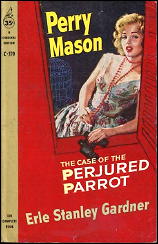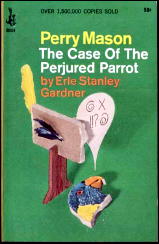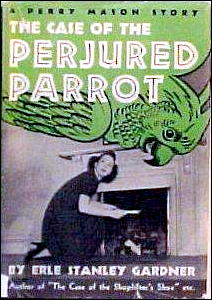Fri 17 Sep 2010
A Review by Mike Grost: ERLE STANLEY GARDNER – The Case of the Perjured Parrot.
Posted by Steve under Pulp Fiction , Reviews[6] Comments

ERLE STANLEY GARDNER – The Case of the Perjured Parrot. William Morrow & Co., hardcover, 1939. Pocket #378; 1st printing, August 1947. Reprinted many times, in both hardcover and soft.
Gardner wrote a series of Western short tales set in desert locales for Argosy magazine (1930-1934). Some of these were collected in Whispering Sands (1981). “Law of the Rope” (1933) and “Carved in Sand” (1933) mix mystery puzzle plot elements, with the sleuth’s reconstruction of events during a crime by tracking trails left in the desert. This sort of reading of physical trails and evidence at a crime scene goes back to Gaboriau in mystery fiction.

The Case of the Perjured Parrot (1939) is a Perry Mason tale, set not in the desert, but in a mountain forest. But it has another hermit-like nature-lover, like several of the desert tales, and an emphasis on reading clues from a murder scene to reconstruct a crime.
These clues are indoors at a fishing cabin, not outside, however, making a further difference from the desert tales. Some of this detection is done not by Perry Mason, but by a country sheriff whose good at “reading trail.”
The long opening (Chapters 1-5) tells a pleasantly elaborate tale, with a great flow of story and several nice twists and turns. Gardner is especially good at spinning out plot.

The solution (Chapters 12-14) is none too surprising, and the novel does not excel therefore as a puzzle plot mystery. Still, the solution’s twists are decent, and continue both the deductions from crime scene clues and the book’s pleasing flood of story.
The Case of the Perjured Parrot consists of one long murder investigation, of a single murder. It is more unified than many Gardner books. There is no preliminary mystery subplot in the opening chapters either: Perry Mason starts investigating the murder in the first chapter. Perry works less to defend a single client in this tale, and more purely as a detective, as well.
The Case of the Perjured Parrot, like the desert-set The Case of the Drowsy Mosquito, has a bit of high technology in it. Gardner perhaps had some artistic association between nature settings and technology, in his story-creation process.
Recommended.

September 18th, 2010 at 4:55 am
At his best, and this is close to it, I always think we underestimate how good and consistent Gardner was. We take him and Perry Mason for granted, and shouldn’t.
Even in an average Mason entry you were going to get a decent mystery plot, some solid detective work, and a couple of decent courtroom scenes. In that the books are models of construction and execution, and this is from early enough in the series it was still fresh and Perry a bit rawer and less refined than he would become in later books.
That said, I don’t read many of today’s legal thrillers (any actually) because in most case Gardner did it faster, slicker, and often with more real punch, and did it over and over again. With few exceptions most of today’s legal thrillers seem to me to have more verbiage without really adding much more kick.
September 18th, 2010 at 10:00 am
The original book jacket for “Parrot” is really interesting. It’s rare to see jackets that mix photos and drawings.
Before this, don’t recall ever seeing an original hardback jacket for any Gardner book.
September 19th, 2010 at 6:49 am
Mike
There is a site that sells Facsimile Dust Jackets and among their many covers they boast several Gardner’s if you just want to see them. They also have Van Dine, Buchan, Sapper, Marquand, and others.
September 20th, 2010 at 11:05 am
At one time, by the time Gardner died, perhaps, I’m sure I’d read all of the Perry Mason’s, but there were so many, it’s very possible I missed one or two.
I gobbled them up like crazy when I first discovered them, while in junior high at the local library, then in paperback, but I’ve been disappointed in various ways when I’ve sampled them recently.
The plots don’t seem to hold up as well as I remembered, and Gardner’s verbal mannerisms are a lot more noticeable now. I ought to try some he wrote back in the 30s, though, like PERJURED PARROT. Most of what I’ve read recently have come from the mid-50s on, and maybe Gardner had started to coast by then.
— Steve
September 20th, 2010 at 11:52 am
The later Mason’s are a bit more mechanical and formulaic than the earlier ones though there are still good entries like TCOT THE SUN BATHER’S DIARY, or CARELESS KITTEN (where Della ends up briefly on trial), or even GRINNING GORILLA just because Perry decks a man in a gorilla suit.
But the Mason of the early books is much more in line with Gardner’s pulp creations, faster with his fists and apt to be found standing on a ledge spying on a naked woman. He plays faster and looser with ethics and the law, and hoves closer to some of his influences like his namesake Melville Davidson Post’s Randolph Mason and Baroness Orczy’ Skin-o-My-Tooth.
I’ve always wondered how much — if at all — the Ephraim Tutt stories influenced Perry and his creator, but as yet no one has written about it.
September 20th, 2010 at 12:27 pm
I don’t think anyone remembers the Tutt stories any more, but at one time, both he and his creator Arthur Train were very well known, perhaps as solidly established in the public’s mind as were Holmes and Conan Doyle.
Mike Nevins has a great online article about both Train and Mr. Tutt:
http://tarlton.law.utexas.edu/lpop/etext/lsf/nevins19.htm
Tutt’s goal was justice, not the technicalities of the law, and David, I think you’re on to something in pointing out the influence he may have had on Gardner.
— Steve